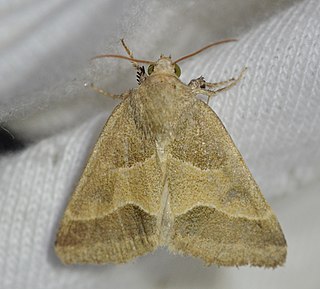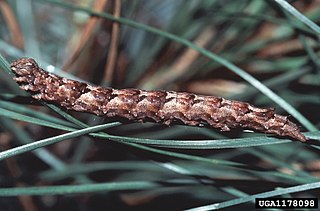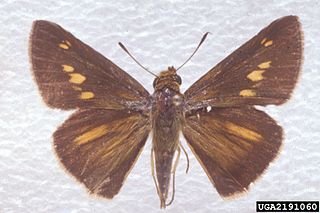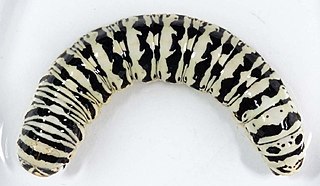
Acronicta lanceolaria is a moth of the family Noctuidae. It is found in North America, from Nova Scotia to British Columbia. It is listed as a species of special concern and believed extirpated in the US state of Connecticut.

Argyrostrotis anilis, the short-lined chocolate, is a moth of the family Noctuidae. The species was first described by Dru Drury in 1773. It is found in North America from Quebec and Ontario, down through the eastern United States to Florida and Texas. It is listed as a species of special concern in the state of Connecticut.

Schinia gracilenta, the slender flower moth or iva flower moth, is a moth of the family Noctuidae. The species was first described by Jacob Hübner in 1818. It is found from the US states of New York to Florida and Nebraska to Arizona. The species is listed as endangered in Connecticut.

The pink star moth is a species of moth of the family Noctuidae. It is found from southern Maine to Florida, west to Missouri and Texas.

Zale submediana, the gray spring zale, is a moth of the family Noctuidae. The species was first described by Strand in 1917. It is found in the US from Wisconsin to Maine, south to New Jersey and in mountains to North Carolina.
Melitara prodenialis is a moth of the family Pyralidae described by Francis Walker in 1863. It is native to North America, where it is known from south-eastern New York to Florida along the Atlantic coastal plain, and west to eastern Oklahoma and north-central and south-eastern Texas. It is an introduced species in Hawaii. It is a special concern species in Connecticut.

Euphyes dion, the Dion skipper or Alabama skipper, is a species of butterfly of the family Hesperiidae. It is found in scattered populations along the Atlantic coast of North America, from western Massachusetts and south-eastern New York south to north-eastern Florida, west to north-eastern Texas, and north to south-eastern North Dakota, northern Wisconsin, southern Ontario and southern Quebec. It is listed as a species of special concern in the US state of Connecticut.
Drasteria occulta, the occult drasteria moth, is a moth of the family Erebidae. The species was first described by Henry Edwards in 1881. It is found in North America, where it has been recorded from coastal areas in Maine, New Jersey, Pennsylvania and Texas. It is listed as a species of special concern and believed extirpated in the US state of Connecticut.

Glena cognataria, the blueberry gray moth, is a moth native to North America. It ranges from Florida to Nova Scotia and New Brunswick. Its larvae is hosted on blueberry. The habitat consists of bogs and pine barrens. It is listed as a species of special concern and believed extirpated in the US state of Connecticut.

Cucullia speyeri, common names Speyer's paint, Speyer's cucullia or Speyer's hooded owlet moth, is a moth found in North America. It is found from Alberta and Montana to the Atlantic coast from New Hampshire to Virginia. It was described by Joseph Albert Lintner in 1874. In the US state of Connecticut, it is listed as a species of special concern and is believed to be extirpated. The habitat consists of open meadows, dry grasslands and native prairies.
Hydraecia immanis, the hop vine borer moth is a moth in the family Noctuidae native to North America. The species was described by Achille Guenée in 1852. It is listed as a species of special concern and is believed to be extirpated from the US state of Connecticut.
Papaipema sciata, or Culver's root borer moth, is a species of moth found in North America, where it has been recorded from Connecticut, Maine, New York, New Jersey, Iowa, Michigan, Missouri, Minnesota, Illinois, and Wisconsin. It is listed as a species of special concern and believed extirpated in the US state of Connecticut. The species was first described by Henry Bird in 1908.

Sideridis maryx the maroonwing moth, is a species of moth native to North America. In the US state of Connecticut, it is listed as a species of special concern and is believed to be extirpated. The larval food plant is unknown, but it is suspected to be a specialist feeding on Arctostaphylos uva-ursi. The species was first described by Achille Guenée in 1852.
Apamea lintneri, the sand wainscot moth, is a species of moth native to North America. It is listed as a species of special concern in the US state of Connecticut. The species was described by Augustus Radcliffe Grote in 1873.
Euxoa violaris, the violet dart moth, is a species of moth native to North America. It is listed as a species of special concern in the US state of Connecticut. It was described by Augustus Radcliffe Grote and Coleman Townsend Robinson in 1868.

Meropleon ambifusca, or Newman's brocade, is a species of cutworm or dart moth in the family Noctuidae. It was described by Newman in 1948 and is found in North America.
Lithophane viridipallens, the pale green pinion moth, is a moth of the family Noctuidae that is native to North America. It is listed as a species of special concern in the US state of Connecticut. It was described by Augustus Radcliffe Grote in 1877.
Sympistis perscripta, the scribbled sallow moth is a moth of the family Noctuidae that is native to North America. It is listed as a species of special concern in the US states of Connecticut and Massachusetts. It was described by Achille Guenée in 1852. The larval hosts are Antirrhinum, Linaria, and Nuttallanthus.
Photedes inops, common name Spartina borer moth, is a species of moth native to North America. The larvae are hosted on Spartina pectinata, apparently exclusively. It is listed as a species of special concern in the US state of Connecticut.
Metarranthis apiciaria, the barrens metarranthis moth, is a moth in the family Geometridae that is native to North America. The species was first described by Packard in 1876. It is listed as endangered in Massachusetts, and as a species of special concern in Connecticut.









